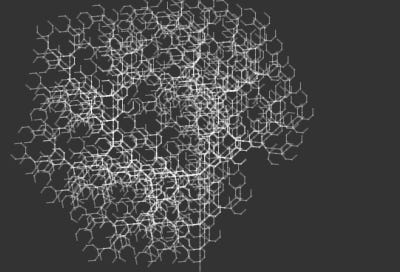The Power of Lindenmayer Systems: A Journey from Code to Natural Patterns
How simple rules in a Lindenmayer System can generate complex, organic structures for Art, Design, and beyond
Imagine creating the intricate branching patterns of trees, the spirals of shells, or the veins in leaves using only a few lines of code. This is the power of a Lindenmayer System, or L-system, a mathematical formalism that uses a set of simple rules to generate complex, natural-looking patterns. Initially developed by biologist Aristid Lindenmayer to model the growth of plants, L-systems have found applications in computer graphics, procedural content generation, and even artificial intelligence.
Explanation
At its core, an L-system is a type of formal grammar consisting of a hypothesis (a starting string), a set of production rules, and an interpretation method that converts the string into geometric shapes. The example code (do you have it at the end of this text) starts with a hypothesis "F", representing a forward move. The rule specified, F -> FF+[+F-F-F]-[-F+F+F], is applied iteratively, transforming the string into more complex sequences.
Here’s a breakdown of how the code works:
Axiom: The starting point is a simple "F", representing a straight line segment.
Rules: The transformation rule replaces "F" with
FF+[+F-F-F]-[-F+F+F]. This rule is applied iteratively, meaning that the sequence becomes increasingly complex with each generation.Turtle Graphics: The string is interpreted using turtle graphics, where "F" draws a line forward, "+" rotates the direction by a given angle, "-" rotates it in the opposite direction, and "[" and "]" push and pop the current drawing state (like saving and restoring the position and orientation of the "turtle").
In the example, each iteration generates a more detailed and branching pattern reminiscent of natural forms like ferns or corals.
Why It's Relevant
Lindenmayer Systems are not just a tool for generating beautiful patterns; they embody the concept of emergence—complex structures arising from simple rules. This principle is critical in various domains, from biology to artificial intelligence, where understanding how complexity can emerge from simplicity is critical to innovation.
Interest in the Business Sector
For businesses, L-systems offer many opportunities, especially in industries requiring procedural content generation, such as gaming, film, and virtual reality. They can be used to create realistic environments, textures, and structures with minimal computational resources, saving both time and costs. In architecture and urban planning, L-systems can simulate the growth of cities or the layout of streets and green spaces, providing a powerful tool for planning and design.
Moreover, the principles of L-systems are applicable in data science and machine learning, where understanding recursive patterns and growth processes can lead to more efficient algorithms and predictive models.
Use Cases
Game Development: L-systems are used to procedurally generate natural landscapes, trees, and plant life in video games, creating rich, immersive environments that feel organic and alive.
Film and Animation: In visual effects, L-systems help generate realistic vegetation and fractal-like structures, adding depth and realism to scenes without manual modelling.
Architecture: Architects and urban planners use L-systems to simulate and optimize the layout of natural and urban environments, allowing for creating spaces that integrate seamlessly with the natural world.
AI and Machine Learning: Understanding L-systems helps develop algorithms that can learn and predict recursive, fractal-like patterns in data, enhancing AI capabilities in fields like predictive modeling and anomaly detection.
Lindenmayer Systems have not only influenced computer science and art but also inspired entire genres of generative art. Artists use algorithms like L-systems to create works that evolve and grow organically, often with surprising and intricate outcomes. These creations often blur the line between human-made and nature-inspired, leading to a fascinating exploration of creativity through code.
So What?
The Lindenmayer System is a striking example of how simplicity can lead to complexity, offering a powerful tool for generating natural patterns and structures. Whether you're a developer, designer, or scientist, the principles behind L-systems can unlock new levels of creativity and efficiency in your work. As we explore the intersections of nature, art, and technology, L-systems remind us that the most intricate and beautiful patterns often have the simplest origins.
Explore the code that generated the previous images:
let angle;
let axiom = "F";
let sentence = axiom;
let len = 100;
let slider;
let rules = [];
rules[0] = {
a: "F",
b: "FF+[+F-F-F]-[-F+F+F]"
};
function generate() {
len *= 0.5;
let nextSentence = "";
for (let i = 0; i < sentence.length; i++) {
let current = sentence.charAt(i);
let found = false;
for (let j = 0; j < rules.length; j++) {
if (current == rules[j].a) {
found = true;
nextSentence += rules[j].b;
break;
}
}
if (!found) {
nextSentence += current;
}
}
sentence = nextSentence;
turtle();
}
function turtle() {
background(51);
resetMatrix();
translate(width / 2, height);
stroke(255, 100);
for (let i = 0; i < sentence.length; i++) {
let current = sentence.charAt(i);
if (current == "F") {
line(0, 0, 0, -len);
translate(0, -len);
} else if (current == "+") {
rotate(angle);
} else if (current == "-") {
rotate(-angle);
} else if (current == "[") {
push();
} else if (current == "]") {
pop();
}
}
}
function setup() {
createCanvas(400, 400);
angle = radians(25);
background(51);
turtle();
let button = createButton("generate");
button.mousePressed(generate);
slider = createSlider(0, TWO_PI, PI / 4, 0.01);
}
function draw() {
angle = slider.value();
background(51);
turtle();
}



